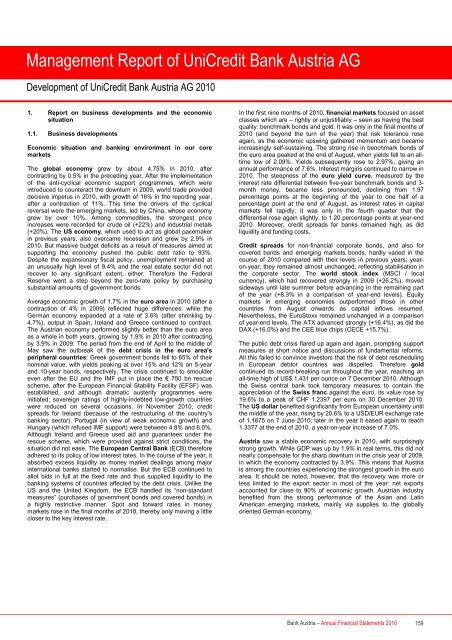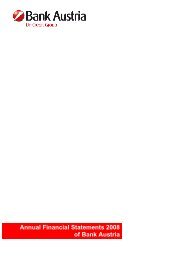Annual Financial Statements 2010 of Bank Austria
Annual Financial Statements 2010 of Bank Austria
Annual Financial Statements 2010 of Bank Austria
You also want an ePaper? Increase the reach of your titles
YUMPU automatically turns print PDFs into web optimized ePapers that Google loves.
Management Report <strong>of</strong> UniCredit <strong>Bank</strong> <strong>Austria</strong> AG<br />
Development <strong>of</strong> UniCredit <strong>Bank</strong> <strong>Austria</strong> AG <strong>2010</strong><br />
1. Report on business developments and the economic<br />
situation<br />
1.1. Business developments<br />
Economic situation and banking environment in our core<br />
markets<br />
The global economy grew by about 4.75% in <strong>2010</strong>, after<br />
contracting by 0.5% in the preceding year. After the implementation<br />
<strong>of</strong> the anti-cyclical economic support programmes, which were<br />
introduced to counteract the downturn in 2009, world trade provided<br />
decisive impetus in <strong>2010</strong>, with growth <strong>of</strong> 16% in the reporting year,<br />
after a contraction <strong>of</strong> 11%. This time the drivers <strong>of</strong> the cyclical<br />
reversal were the emerging markets, led by China, whose economy<br />
grew by over 10%. Among commodities, the strongest price<br />
increases were recorded for crude oil (+22%) and industrial metals<br />
(+20%). The US economy, which used to act as global pacemaker<br />
in previous years, also overcame recession and grew by 2.9% in<br />
<strong>2010</strong>. But massive budget deficits as a result <strong>of</strong> measures aimed at<br />
supporting the economy pushed the public debt ratio to 93%.<br />
Despite the expansionary fiscal policy, unemployment remained at<br />
an unusually high level <strong>of</strong> 9.4% and the real estate sector did not<br />
recover to any significant extent, either. Therefore the Federal<br />
Reserve went a step beyond the zero-rate policy by purchasing<br />
substantial amounts <strong>of</strong> government bonds.<br />
Average economic growth <strong>of</strong> 1.7% in the euro area in <strong>2010</strong> (after a<br />
contraction <strong>of</strong> 4% in 2009) reflected huge differences: while the<br />
German economy expanded at a rate <strong>of</strong> 3.6% (after shrinking by<br />
4.7%), output in Spain, Ireland and Greece continued to contract.<br />
The <strong>Austria</strong>n economy performed slightly better than the euro area<br />
as a whole in both years, growing by 1.9% in <strong>2010</strong> after contracting<br />
by 3.9% in 2009. The period from the end <strong>of</strong> April to the middle <strong>of</strong><br />
May saw the outbreak <strong>of</strong> the debt crisis in the euro area’s<br />
peripheral countries: Greek government bonds fell to 65% <strong>of</strong> their<br />
nominal value, with yields peaking at over 15% and 12% on 5-year<br />
and 10-year bonds, respectively. The crisis continued to smoulder<br />
even after the EU and the IMF put in place the € 750 bn rescue<br />
scheme, after the European <strong>Financial</strong> Stability Facility (EFSF) was<br />
established, and although dramatic austerity programmes were<br />
initiated; sovereign ratings <strong>of</strong> highly-indebted low-growth countries<br />
were reduced on several occasions. In November <strong>2010</strong>, credit<br />
spreads for Ireland (because <strong>of</strong> the restructuring <strong>of</strong> the country’s<br />
banking sector), Portugal (in view <strong>of</strong> weak economic growth) and<br />
Hungary (which refused IMF support) were between 4.8% and 6.0%.<br />
Although Ireland and Greece used aid and guarantees under the<br />
rescue scheme, which were provided against strict conditions, the<br />
situation did not ease. The European Central <strong>Bank</strong> (ECB) therefore<br />
adhered to its policy <strong>of</strong> low interest rates. In the course <strong>of</strong> the year, it<br />
absorbed excess liquidity as money market dealings among major<br />
international banks started to normalise. But the ECB continued to<br />
allot bids in full at the fixed rate and thus supplied liquidity to the<br />
banking systems <strong>of</strong> countries affected by the debt crisis. Unlike the<br />
US and the United Kingdom, the ECB handled its “non-standard<br />
measures” (purchases <strong>of</strong> government bonds and covered bonds) in<br />
a highly restrictive manner. Spot and forward rates in money<br />
markets rose in the final months <strong>of</strong> <strong>2010</strong>, thereby only moving a little<br />
closer to the key interest rate.<br />
In the first nine months <strong>of</strong> <strong>2010</strong>, financial markets focused on asset<br />
classes which are – rightly or unjustifiably – seen as having the best<br />
quality: benchmark bonds and gold. It was only in the final months <strong>of</strong><br />
<strong>2010</strong> (and beyond the turn <strong>of</strong> the year) that risk tolerance rose<br />
again, as the economic upswing gathered momentum and became<br />
increasingly self-sustaining. The strong rise in benchmark bonds <strong>of</strong><br />
the euro area peaked at the end <strong>of</strong> August, when yields fell to an alltime<br />
low <strong>of</strong> 2.09%. Yields subsequently rose to 2.97%, giving an<br />
annual performance <strong>of</strong> 7.6%. Interest margins continued to narrow in<br />
<strong>2010</strong>. The steepness <strong>of</strong> the euro yield curve, measured by the<br />
interest rate differential between five-year benchmark bonds and 3month<br />
money, became less pronounced, declining from 1.97<br />
percentage points at the beginning <strong>of</strong> the year to one half <strong>of</strong> a<br />
percentage point at the end <strong>of</strong> August, as interest rates in capital<br />
markets fell rapidly; it was only in the fourth quarter that the<br />
differential rose again slightly, to 1.20 percentage points at year-end<br />
<strong>2010</strong>. Moreover, credit spreads for banks remained high, as did<br />
liquidity and funding costs.<br />
Credit spreads for non-financial corporate bonds, and also for<br />
covered bonds and emerging markets bonds, hardly varied in the<br />
course <strong>of</strong> <strong>2010</strong> compared with their levels in previous years; yearon-year,<br />
they remained almost unchanged, reflecting stabilisation in<br />
the corporate sector. The world stock index (MSCI / local<br />
currency), which had recovered strongly in 2009 (+26.2%), moved<br />
sideways until late summer before advancing in the remaining part<br />
<strong>of</strong> the year (+8.3% in a comparison <strong>of</strong> year-end levels). Equity<br />
markets in emerging economies outperformed those in other<br />
countries from August onwards as capital inflows resumed.<br />
Nevertheless, the EuroStoxx remained unchanged in a comparison<br />
<strong>of</strong> year-end levels. The ATX advanced strongly (+16.4%), as did the<br />
DAX (+16.0%) and the CEE blue chips (CECE +15.7%).<br />
The public debt crisis flared up again and again, prompting support<br />
measures at short notice and discussions <strong>of</strong> fundamental reforms.<br />
All this failed to convince investors that the risk <strong>of</strong> debt rescheduling<br />
in European debtor countries was dispelled. Therefore gold<br />
continued its record-breaking run throughout the year, reaching an<br />
all-time high <strong>of</strong> US$ 1,431 per ounce on 7 December <strong>2010</strong>. Although<br />
the Swiss central bank took temporary measures to contain the<br />
appreciation <strong>of</strong> the Swiss franc against the euro, its value rose by<br />
19.6% to a peak <strong>of</strong> CHF 1.2397 per euro on 30 December <strong>2010</strong>.<br />
The US dollar benefited significantly from European uncertainty until<br />
the middle <strong>of</strong> the year, rising by 20.6% to a USD/EUR exchange rate<br />
<strong>of</strong> 1.1875 on 7 June <strong>2010</strong>; later in the year it eased again to reach<br />
1.3377 at the end <strong>of</strong> <strong>2010</strong>, a year-on-year increase <strong>of</strong> 7.0%.<br />
<strong>Austria</strong> saw a stable economic recovery in <strong>2010</strong>, with surprisingly<br />
strong growth. While GDP was up by 1.9% in real terms, this did not<br />
nearly compensate for the sharp downturn in the crisis year <strong>of</strong> 2009,<br />
in which the economy contracted by 3.9%. This means that <strong>Austria</strong><br />
is among the countries experiencing the strongest growth in the euro<br />
area. It should be noted, however, that the recovery was more or<br />
less limited to the export sector in most <strong>of</strong> the year: net exports<br />
accounted for close to 90% <strong>of</strong> economic growth. <strong>Austria</strong>n industry<br />
benefited from the strong performance <strong>of</strong> the Asian and Latin<br />
American emerging markets, mainly via supplies to the globally<br />
oriented German economy.<br />
<strong>Bank</strong> <strong>Austria</strong> – <strong>Annual</strong> <strong>Financial</strong> <strong>Statements</strong> <strong>2010</strong> 159
















